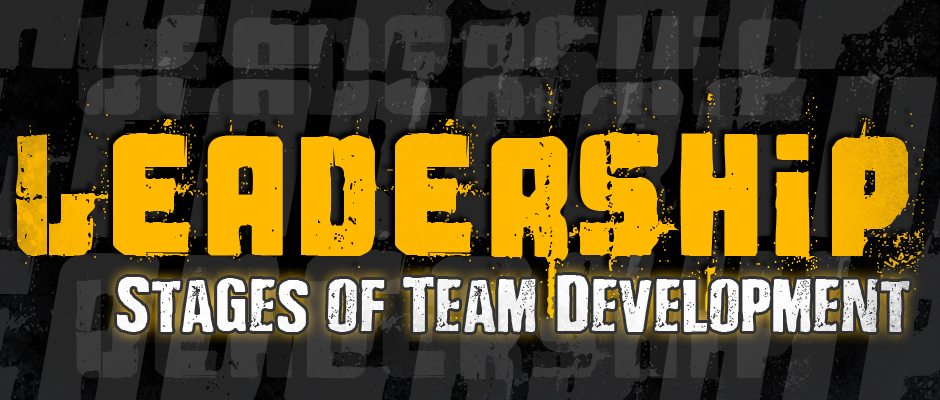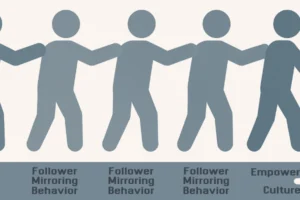Team Development – Stages
Imagine for a moment that you have been placed into a leadership position of a cross-functional task force, responsible for developing a specific process or goal for your organization. The selected team members will move to the same location (at headquarters) for three months.
You need to understand that smooth transitions should not be expected or taken for granted. You should expect to see a series of behaviors during each team development stage. Each stage (Forming, Storming, Norming, Performing, and Adjourning) presents its own identities, challenges, and expected behaviors (McShane, & Von, G. M. A. Y., 2013). You need to recognize each stage of this process.
Forming
During the forming stage, the team members are more than likely excited about the tasks or challenges laid out before them, but all are trying to discover the expectations. Some might find themselves to be a little anxious or nervous (Manktelow, 2014). Others might find themselves to be emboldened and eager. However, overall the team will probably be mostly polite and generally positive as they get to know their new team members a little more (McShane, & Von, G. M. A. Y., 2013).
Furthermore, the roles of each team member might be a little unclear, and leadership might be tested or contested (McShane, & Von, G. M. A. Y., 2013). There will more than likely be a lot of questions about the team’s direction, specific objectives, and plans. Some processes might be ignored or missing altogether. Each leader and/or member will strive to bring clarity to these missing pieces, which will more than likely lead to the “storming” stage, but this comes with strong evaluations of the value of each member by the others (Manktelow, 2014).
Storming
This phase is defined by interpersonal conflict and influence (McShane, & Von, G. M. A. Y., 2013). During this phase of team development, certain members will begin to press their boundaries. These boundaries might have been established during the forming stage or maybe the result of individual working styles. Differing working styles often cause unforeseen problems, which may become frustrating to the other team members. Some members may resist a certain project or task (Manktelow, 2014).
Team members may begin to challenge the authority or expertise of another. They may maneuver for better positioning as their roles become clarified. Power struggles or a strong possibility during this stage. Some may feel overwhelmed by their workload or resentful of their workload in comparison to other members (Manktelow, 2014). Sometimes, resistance can be created out of a simple disagreement of approach in regard to certain tasks. This stage is survived by remaining focused on goals, avoiding emotional issues, and proactive compromise wherever possible. Experienced leadership is critical if the team is to survive.
Norming
When the authority of the leader is acknowledged and respected, and the team begins to resolve their differences and appreciate their colleagues’ strengths, they have entered what is known as the “Norming Stage.” This stage comes with a stronger sense of commitment and unity, and leadership often becomes shared at this point (McShane, & Von, G. M. A. Y., 2013). The team will begin to develop their strengths together. The team knows one another much better and may even socialize.
The team may find they are able to ask each other for help and provide constructive feedback. Roles and responsibilities become clear and accepted (McShane, & Von, G. M. A. Y., 2013). Some of the bigger decisions may be made by consensus, and smaller decisions may be delegated to a team member, and the direction chosen will be trusted by the team.
Performing
At this stage, the team begins to realize the team’s goals (McShane, & Von, G. M. A. Y., 2013). The processes are fine-tuned, and the work proceeds without massive friction for the most part. For the most part, the team knows what it is doing and can begin to utilize the strengths of each individual member (Manktelow, 2014).
The organization can stand on its own because the members are task-oriented and committed. The priority shifts to over-achieving the goals already being met and becoming efficient in regard to coordination (Manktelow, 2014). The team and its members operate with a higher degree of autonomy because there is a much higher degree of cooperation and trust.
When disagreements occur, they tend to be resolved in a positive way. Tweaks are made to the overall process but are usually done so now in consensus (McShane, & Von, G. M. A. Y., 2013). The team also begins to look out for one another at this stage. Essentially, the train is in motion, and the only things that can stop it are issues with the rails, running out of fuel, or hitting the brakes.
Adjourning
While this stage is inevitable, it is understood as a necessary part of the cycle. Teams are disbanded through organizational restructuring or basic disbanding. The hope is that this stage is met when the overall goal is completed successfully or the organization’s purpose has been fulfilled. This is when the team members move on to new things.
Conclusion
Smooth transitions should never be expected or taken for granted when a new team or organization is being formed. Team development is a process. We should expect to see a series of behaviors during each stage of the team’s development. Each stage (Forming, Storming, Norming, Performing, and Adjourning), presents its own identities, challenges, and expected behaviors, but when understood, expected, and navigated properly, the organization has a better chance of overcoming the hurdles and seeing success.
Be sure to check my article titled, “The Difficulty of Change and How to Overcome It.”
Resources for Team Development
Manktelow, J. (2014, January 1). Forming, Storming, Norming, and Performing: Understanding the Stages of Team Formation. Forming, Storming, Norming, and Performing. Retrieved , from http://www.mindtools.com/pages/article/newLDR_86.htm
McShane, S. L., & Von, G. M. A. Y. (2013). Organizational behavior: Emerging knowledge, global reality. New York: McGraw-Hill Irwin.




